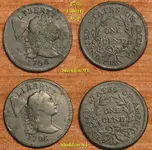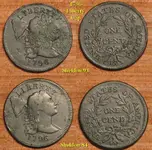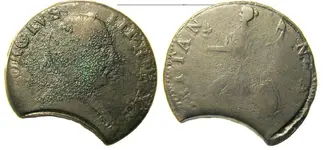Don in SJ
Silver Member
- Joined
- May 20, 2005
- Messages
- 4,937
- Reaction score
- 852
- Golden Thread
- 0
- Detector(s) used
- MINELAB SE Pro
- Primary Interest:
- All Treasure Hunting
On Today's Finds a discussion started concerning Chris's 1794 Large Cent that is great on one side and not so on the other and it sounds like a good discussion item so rather than have it attached to Chris's nice 1794 post I thought a separate post here might work.
Here are some of my early morning thoughts on the subject:
Some reasons for one side good, other side bad: Sitting undisturbed in one position I believe is first and foremost condition for this to happen, but could be wrong, however I do not hunt plowed fields and have quite a few coins from the 1700s with one side great and the other side damaged by corrosion.
My thoughts are, man applied fertilizers, cow/deer/horse, etc urine. Laying in one position in normal acidic soil (Southern NJ soil is naturally highly acidic) that remains wetter than other areas. I am sure there are others, I don't buy the acid rain being a major contributor since it would be more general finding the damaged coins.
Type of soil and drainage is of the utmost importance in determining the condition of coppers in the ground.
Another thought, are we positive it is the top side that gets the corrosion and not the bottom? If you leave a piece of wet metal on top of the ground, of course the top side dries first and the bottom stays wet very long, so a coin buried in ground that does dry out at times, would leave the top drying out more often than the bottom side, just another thought.
Attaching 3 coins found at the same sawmill site in 2007 or so and two of the three have same type of one sided corrosion. Now is it from there position in the ground, since one copper does not have it. The soil was well drained sandy soil, it was not farmed at all unless it was done before the 1790s. The area now is lightly wooded with Oak and Pine trees and minimum underbrush.
These two 1796 Liberty Caps were found within 100 feet of each other, but I do believe the one with the corrosion was found and couple inches deeper (8-10") and on what was once an old wagon road next to the sawmill.

But the KGIII counterfeit was found uphill from the two 1796s, but within 100 feet of the other corroded one and yet it has the same type of one sided corrosion. This was about 5-7 inches down in sandy soil.

Don
Here are some of my early morning thoughts on the subject:
Some reasons for one side good, other side bad: Sitting undisturbed in one position I believe is first and foremost condition for this to happen, but could be wrong, however I do not hunt plowed fields and have quite a few coins from the 1700s with one side great and the other side damaged by corrosion.
My thoughts are, man applied fertilizers, cow/deer/horse, etc urine. Laying in one position in normal acidic soil (Southern NJ soil is naturally highly acidic) that remains wetter than other areas. I am sure there are others, I don't buy the acid rain being a major contributor since it would be more general finding the damaged coins.
Type of soil and drainage is of the utmost importance in determining the condition of coppers in the ground.
Another thought, are we positive it is the top side that gets the corrosion and not the bottom? If you leave a piece of wet metal on top of the ground, of course the top side dries first and the bottom stays wet very long, so a coin buried in ground that does dry out at times, would leave the top drying out more often than the bottom side, just another thought.

Attaching 3 coins found at the same sawmill site in 2007 or so and two of the three have same type of one sided corrosion. Now is it from there position in the ground, since one copper does not have it. The soil was well drained sandy soil, it was not farmed at all unless it was done before the 1790s. The area now is lightly wooded with Oak and Pine trees and minimum underbrush.
These two 1796 Liberty Caps were found within 100 feet of each other, but I do believe the one with the corrosion was found and couple inches deeper (8-10") and on what was once an old wagon road next to the sawmill.

But the KGIII counterfeit was found uphill from the two 1796s, but within 100 feet of the other corroded one and yet it has the same type of one sided corrosion. This was about 5-7 inches down in sandy soil.

Don
Attachments
Upvote
0




